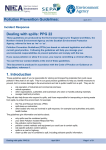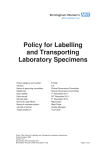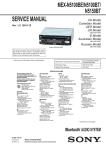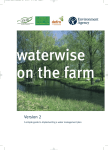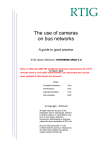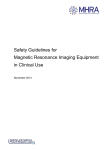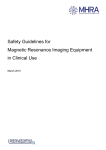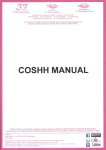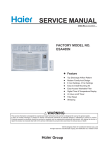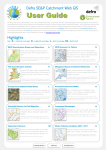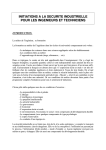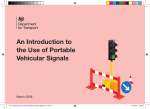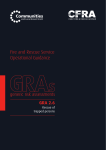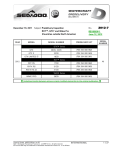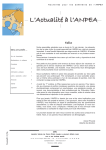Download Pollution Prevention Guidelines
Transcript
Pollution Prevention Guidelines Incident Response - dealing with spills: PPG22 These guidelines are produced by the Environment Agency for England and Wales, the Northern Ireland Environment Agency and the Scottish Environment Protection Agency, referred to here as ‘we’ or ‘us’. Pollution Prevention Guidelines (PPGs) are based on relevant legislation and reflect current good practice. Following the guidelines will help you to manage your environmental responsibilities to prevent pollution and comply with the law. If you cause pollution or allow it to occur, you may be committing a criminal offence. You can find our contact details at the end of these guidelines. This document is produced in accordance with the Code of Practice on Guidance on Regulation, reference 1. 1. Introduction These guidelines will help you if you’re responsible for storing and transporting materials, that could cause pollution if they are spilt. They will help you identify measures to prevent and mitigate pollution of the water environment. They are written for: • site operators of industrial and commercial premises; • vehicle operators; • other organisations, authorities and individuals who store or handle polluting materials; • spill clean up contractors; • the Fire and Rescue Service; • sewage treatment providers; • other bodes who maybe involved in spill response, for example Local Authorities and public health bodies. They’re our good practice guidelines to help you deal with a spill of polluting materials to land, surface waters or ground water. Following them will help you prevent or reduce environmental damage and risk to public health. But if you do have a spill, on site or during material transit, you are responsible for it’s clean up and, if necessary, restoration of the environment. The guidelines give information about: • why spills must be contained quickly; • the pollution control hierarchy; • pollution control methods and equipment you could use to contain spills; • site specific pollution control options; • your sites pollution Incident Response Plan; • spills on a road or highway; • clean up after you’ve contained a spill, including pollutant specific information. The guidelines don’t cover how you can prevent damage from the effects of contaminated water caused by fire fighting. These are covered in other guidelines, references 2, 3 and 4. The guidelines may be used to supplement guidance for sites controlled under the Control of Major Accident Hazard Regulation 2007 (reference 5) and the Environmental Permitting Regulations 2010 (reference 6). Under these regulations you have a statutory obligation to have an Accident Prevention plan in place. Following these guidelines may be appropriate measures for your accident prevention plan.. If your site is covered by these regulations and you don’t follow these guidelines you should be able to justify the reason and show that the measures you’ve taken are equivalent or better. Although, the guidelines don’t give advice on public health aspects of a spill incident, health and safety is an important consideration. You should assess the safety risks of each incident before you take any action to contain or control a spill. DRAFT - Incident response – dealing with spills, PPG 22: month 2010 Page 1 of 19 2. Background Many different materials have the potential to cause significant environmental harm if they’re spilt and are allowed to enter the environment. Polluting materials include things we can clearly identify as harmful, such as chemicals, pesticides, oils, sewage and animal slurries. But many things we don’t see as harmful can still have a devastating effect on the environment, for example beverages, food products, detergents, dairy products, paint and ink. Impacts can include: • the closure of public water supplies and other abstractions; • damage to fisheries and river ecosystems; • disruption of recreational and other river uses; • groundwater or land contamination; • impacts on public health. These impacts can be immediate and long lasting. If you’re the polluter you may be responsible for the clean up costs. These can be expensive, particularly if groundwater has been contaminated. There may also be additional costs associated with our incident response. And fines or costs applied through the criminal courts. Your business reputation can suffer and your insurance costs may rise. The impact a spill will have is affected by the: • polluting or toxic nature of the material that’s spilt; • quantity and concentration of the material released; • environmental sensitivity of the local area around the spill; • the time of year and weather conditions; • availability of pollution control equipment and spill containment facilities; • the speed and effectiveness of your incident response. Even small spills can have a significant impact. Inappropriate or delayed action can make the polluting impact worse and/or threaten public health. Your initial response to a spill can make a big difference to what happens to the environment, public health and your clean up costs. Contingency planning is the key to stopping a spill becoming a serious pollution incident. Pollutants can escape from your site or the where a collision has happened into the environment via different routes: • Through the surface water drainage system. • Direct run-off into a water course. • Directly soaking into ground to the groundwater. • Through the foul sewer system, where pollutants can pass through sewage treatment or reducing the performance of the works so it can’t treat received sewage properly. You should consider both preventative measures, such as installing spill control facilities, and a site specific incident response plan that takes account of your activates and the materials you store and deal with. A site specific incident response plan can include a plan for accidents or spills from materials in transit, for example due to road traffic collisions. Your incident response plan should include the priority actions you should take. Our guidance on ‘Incident response planning: PPG21’, reference 7, gives you advice on writing your plan. The Environmental Damage Regulations (EDR), reference 8, require people who operate an ‘economic’ activity to prevent or limit the environmental damage they cause. This includes: • private businesses; • farming; • manufacturing; • construction and demolition; • waste management; • forestry; • public sector – schools, hospitals and government departments or agencies; • charitable and voluntary organisations. DRAFT - Incident response – dealing with spills, PPG 22: month 2010 Page 2 of 19 The EDR force polluters to prevent and remedy environmental damage they have caused. They follow the 'polluter pays' principle. If you or your business carry out an activity that causes environmental damage you will have to remedy the damage. If there’s a risk of damage from your business activities, you must do your best to prevent the damage occurring. 3. Dealing with spills key points Carry out a pollution risk assessment that includes information about: • What you store or transport; • What could happen if it’s spilt; • Drainage systems, water courses and protected environments on and around your site; • Health and safety for pollution management. More detail is in section 4. Prepare, plan and practice your Pollution Incident Response Plan and make sure you have all the equipment you may need. More detail is in section 5. Use the pollution control hierarchy to help you plan your spill response: • Contain at source • Contain on the surface • Contain close to course • Contain in the drainage system • Contain on the watercourse. More detail is in section 6. Select suitable pollution prevention equipment and emergency response options to help your incident response plan. Contain at source • Leak sealing putty or equipment; • Secure emergency containers; • Closing valves. Contain close to course • Sorbents; • Collect in portable containers. Contain on the surface • Booms; • Sorbents; • Drain mats; • Temporary storage containers and portable tanks. More detail is in section 7. Contain in the drainage system • Oil separators; • Penstock and pollution control valves; • Pipe blockers. Contain on the watercourse • River booms; • Damming. Consider site specific pollution control options tailored to your needs. • Containment lagoons and ponds; • Tanks; • Sacrificial areas; • Pits and trenches. More detail is in section 8. If you transport materials by road consider what you can do if you have a spill or collision. • Correct signage; • Vehicle spill kits; • Fuel tank and Adblue spills. More detail is in section 9. DRAFT - Incident response – dealing with spills, PPG 22: month 2010 Page 3 of 19 You are responsible for cleaning up any spilt material and the safe legal disposal of any waste from a spill. We recommend you use a UK Spill contractor to help you clean up. • Check you legal obligations for waste management; • Sewer jetting; • Highways clean up; • Material specific clean up More detail is in section 10. 4. Your risk assessment Spills often happen when you’re least expecting them. Causes include: • overfilling or poor handling of storage containers, for example drums, intermediate bulk containers and tanks; • equipment and containment failure; • a collision or accident during transport or delivery; • pipework failure; • weather related problems, for example flooding or high wind damage; • fires or explosions; • deliberate acts. It’s always better to prevent a spill from happening in the first place. Safe secure storage, careful deliveries and training, on site and for drivers, are essential for pollution control. Before you can decide on the most appropriate facilities and equipment for your site or vehicle you should carry out a risk assessment. If you have more than one site you should assess the risk for each site individually. Guidance to help you complete a risk assessment is available in ‘Controlled burn’ PPG 28, reference 3. Alternatively you could hire a consultant to help you complete the risk assessment. Your risk assessment needs to consider the: • physical and chemical properties of any material that maybe spilt; • possible effects of accidents, flooding, vandalism and failure of containment; • location, including how close you are to local water courses, groundwater and protected environmental features, for example Sites of Special Scientific Interest; • surface water drains and foul sewers that flow off your site; • operations and layout of your site, or factors to look out for in road traffic collisions; • risks posed to people and the environment and the extent of the possible damage; • local landscape and different weather conditions that could be reasonably expected at and around your site. Once you’ve completed your risk assessment and identified the measures you need to reduce the chance of a spill causing pollution you should include them in an agreed pollution incident response plan. More information is in section 5 and ‘Pollution incident response planning - PPG 21’ (reference 7) gives guidance to help you write your plan. If you do have a spill your response may need to be modified during an incident, based on a dynamic risk assessment, to take account of the circumstances of each spill. For example during heavy rainfall, if more than one material has been spilt or if the incident is on a highway near members of the public. DRAFT - Incident response – dealing with spills, PPG 22: month 2010 Page 4 of 19 5. Your sites Pollution Incident Response Planning 5.1 Prepare A vital part of dealing with a spill is being able to quickly identify the watercourse, groundwater and drainage systems that will be affected by a spill. This means you can plan what you’ll do for if you have a spill and have pollution control equipment, and possible control devises in strategic places. Drainage systems can be very complex and without preparation valuable time can be wasted in locating outfalls and pollution control devices. You should have a drainage plan drawn up that identifies the surface drains, foul sewers, water courses and where they flow to and any local groundwater. They should also show the location of any pollution control devices and stores of pollution control equipment. This can form part of your incident response plan. 5.2 Plan You should prepare an Incident Response Plan for your site. If you have more than one site you will need a separate plan for each. Information to help you prepare your plan is available in ‘Incident response planning – PPG 21’ reference 7. You could consider sharing the plan with us and your local Fire and Rescue service and the Local Authority as you’re writing it, in case we can help with ideas to make it work well, and when it’s been finished so we have a copy available in case of a pollution incident. We may be able to give you advice about when you should notify us about a spill, for example the size of spill for different materials, or when you should call the Fire and Rescue Service. You should also make sure a copy is easily accessible on site during an incident so it can be referred to. Plans should be as simple as possible and not contain unnecessary detail. 5.3 Practice You should train your staff so they know what they should and shouldn’t do if there’s a spill, where pollution control equipment is and where a copy of the Incident Response Plan is. They should also understand that their health and safety is more important than stopping a spill. If you have bulk storage of pollution material on site, frequent deliveries or regular vehicle movements that could damage storage containers we recommend you organise practices, without an actual spill, to check your employees know what to do. On large sites your local Fire and Rescue Service may be interested in attending the site during a practice. If a spillage occurs off site, depending upon the location, drainage plans may be available from the Highways Agency, Highways Authority, Local Authority or local Water Company. 5.4 Pollution control equipment You should make sure your site has stocks of pollution control equipment, suitable for your stored materials, readily available and where possible near possible spill sites or pollution control opportunities. These could be stored as spill kits. Although equipment may be available from other sources, below, you shouldn’t rely on these as your emergency source as response times will vary and spilt material could cause serious pollution while you are waiting for it to arrive. Our partnership with the Fire and Rescue Service (FRS) includes supplying the FRS with pollution control equipment. Some of this equipment is designed to be carried on the frontline pumps. Other more specialist equipment can be brought rapidly to the scene of an incident if required on a dedicated vehicle or environmental protection unit (EPU). Some large chemical companies who belong to the CHEMSAFE Response Network, see useful websites, may hold stocks of suitable equipment and materials which could be brought to the scene for use by the responding company. Neighbouring businesses may also have equipment stocks you could borrow. But you should check that any products are suitable to use on your spill before using them. DRAFT - Incident response – dealing with spills, PPG 22: month 2010 Page 5 of 19 Member companies of UK Spill offer an emergency response service. We recommend you contact a UK Spill contractor to help with your incident response and clean up. Further details should be obtained directly from individual companies or through UK Spill, see useful web sites. We hold some basic materials which may be available to help deal with a spill. But our response times, especially out of hours, may be a few hours. Our role is primarily as a ‘first aid’ response and we will recharge the costs of any equipment used to you. 6. The pollution control hierarchy If you do have a spill you have a number of options to help you manage it. These are based around the pollution control hierarchy. Many of the facilities, types of equipment and techniques included in the hierarchy are described in Section 7. Where appropriate we’ve also included references to further guidance on specific facilities and techniques. The health and safety of anyone dealing with a spill is more important that stopping the spill. Always assess the risk at a spill before you decide what action to take. The actions detailed in your Pollution Incident Response Plan should follow the pollution control hierarchy to help you reduce the impact of a spill. If you follow the hierarchy the spill is contained as early as possible. This reduces the quantities lost and the level of pollution caused. You may need to use several parts of the hierarchy, for example if a spill that’s been leaking for some time is found. Or to help collection of spilt material you may need to skip a stage in the hierarchy, for example containing in the drainage system instead of on the surface may make it easier to pump the spill to safe storage. Preferred response Contain at source Contain close to source Contain on the surface Contain in the drainage system Least preferred response Contain on or in the watercourse The Fire and Rescue Service Manual on Environment Protection, reference 9, gives more detail about many of the pollution control options outlined here. Information about the types of equipment mentioned in the hierarchy detail, below, is available in section 7. 6.1 Contain at source The most effective place to stop a spill is where the spill is happening, at the source. If the primary container or secondary containment have been breached or failed for any reason, you should try to contain the spill where it’s happening. This will reduce the quantity of material released, meaning there’s less spilt material that can cause pollution. Your options include: • sealing the damaged container or pipework; • turning over a leaking drum so the material can’t leak out; • putting a leaking container into another secure container, for example an overdrum; • close any valves on pipework to stop material flow. DRAFT - Incident response – dealing with spills, PPG 22: month 2010 Page 6 of 19 6.2 Contain close to source If you can’t stop the spill where it’s happening you should aim to stop is as close to the source as possible. Where the spill has escaped from the primary and secondary containers you should try to stop it spreading. Your options include using: • transfer the leaking material into another, undamaged container; • sorbent products, for example sheets or pads or sand, to soak up the spill; • small portable containers to collect the spill, for example pop-up-pools. 6.3 Contain on the surface If the spill is spreading and you can’t safely or effectively contain it near to its source you should aim to stop the material getting into the drainage system. Once a spill has been contained it’s easier to remove or transfer into a suitable container, you should do this as soon as it’s safe. Your containment options include using: • booms to prevent the material spreading, or divert the flow to a selected area; • drain mats to cover sewer openings and manhole covers; • improvised solutions, for example a dam built of earth. 6.4 Contain in the drainage system If the spill has spread so far that it’s already entered the drainage system you should try to keep it there and stop it entering the environment. Your options include: • closing oil separators; • closing penstock valves or pollution control valves; • using pipe blockers. 6.5 Contain on or in the watercourse If the spill has escaped from the drainage system into a watercourse you should try to contain it on or in the watercourse before it spreads and causes more pollution. Your options include: • Deploying a river boom; • Damming the watercourse; These pollution control methods can have effects beyond containing the spilt material, for example affecting river navigation or risk of flooding. You must fully identify the possible effects and risks before including these options in your pollution incident response plan and ask us for advice. 7. Pollution control options and equipment The pollution control hierarchy gives you different options for ways you may be able to control a spill. These options are explained more fully below, with suggestions for pollution control equipment that may help you. The equipment described shouldn’t limit your options. We suggest you ask your risk assessment consultant or pollution control equipment supplier if they can suggest any other options or equipment that would work for you. Some pieces of equipment will need to be maintained or tested to make sure it’s always in working order. You should refer to the manufacturers instructions. Your equipment should be placed near to where it may be needed, for example drain mats near to manhole covers and open drain gullies, and kept securely. Employees should be trained how to use the equipment safely and what suitable Personal Protective Equipment they need. Their health and safety is always more important than stopping a spill. What ever pollution control method you use you should clean up the material that is already spilt as soon as possible, see section 10. DRAFT - Incident response – dealing with spills, PPG 22: month 2010 Page 7 of 19 7.1 Contain at source 7.1.1 Sealing the damaged container or pipework This option involves physically blocking the leak and stopping any further material being spilled. This isn’t a permanent fix and you will have to repair or replace the damaged container or pipework as soon as possible afterwards. Proprietary leak sealing putty. One of the simplest ways to block a leaking container or pipe is to cover the hole with a temporary sealant. Leak sealing putty is available either ready mixed, or as a powder you mix with water. You should place a handful firmly over the hole to stop the leak and prevent a greater spill. A more permanent method may be required before you can move the damaged container. Each type of putty has a different ‘working life’ and you should check how long yours will last to see the time frame you have to make full repairs or replace the container or pipework. Leak sealing equipment. This equipment is designed to use when a tank, storage drum or valve has been punctured or damaged. The equipment may be a pad or clamp you fix over the damaged area like a plaster, or may be a solid or inflatable ‘wedge’ you can insert into the damaged area and inflate. 7.1.2 Turning a container If you can, turn a small container, for example an oil drum, so that the damaged part is to the top and the material is no longer spilling from it. Secure the container so it can’t roll or turn back over. This will give you time to take action to stop already spilt material spreading further and to make other plans to secure the damaged container. 7.1.3 Putting a leaking container into another secure container If possible place a leaking primary container into an undamaged container so that any more material can’t escape. You will need to plan ahead for this option to make sure that what the second container is made from won’t be damaged by the leaking material and cause a bigger problem. Overdrum. These are large plastic drums specifically designed to safely store leaking or damaged drums, or other containers. They are made from chemically resistant plastic, but you should check with your supplier to make sure they’re suitable for the materials you have on site. Liners may be available for overdrums to make re-use easier. An overdrum can also be used as a temporary store for a small quantity of a spilt liquid, see next section. 7.1.4 Close any valves on pipework to stop material flow Depending on where the spill is coming from it may be possible to close valves in the pipe work to stop, or minimise, the amount of material that can be spilt. For example if damage to a fuel delivery pump means that oil is spilling from the system you may be able to close a valve where the pipe to the pump leaves the primary container or secondary containment so that only the oil in the pipe can escape. 7.2 Contain close to source 7.2.1 Transferring the leaking material into another, undamaged container If you can safely move the material that is spilling onto another container it will limit the size of the spill. You’ll need to have a suitable pump available, which may need to be safe for use in flammable environments. Manual pumps may be suitable for small spills but would be inefficient for moving large volumes. 7.2.2 Use sorbent products to soak up the spill Sorbents are usually available as loose granules, sheets or rolls, pillows or booms. They can be used to soak up a spill and stop it spreading. There are different types of sorbent available for DRAFT - Incident response – dealing with spills, PPG 22: month 2010 Page 8 of 19 example oil selective or chemically resistant sorbents. These types are described in British Standard BS 7959 Part 1: 2004, reference 10. You will need to select the appropriate sorbent for the materials on your site. Guidance is available to help you choose the right sorbent for your product and site, reference 11. Because using sorbents generates waste they should only be used on small spills, or where a spill has been contained to stop any further spread. All used sorbents must be disposed of according to the Duty of Care and, if soaked in oil or chemicals, may be hazardous waste (special waste in Scotland) see section 10. 7.2.3 Use small portable containers to collect the spill You may be able to collect material that’s spilling as it leaves the primary container or secondary containment. For example a damaged vehicle fuel tank of split pipework. Portable storage tanks are usually made from synthetic rubber, polymers or reinforced plastic, they come in a wide variety of sizes. The small pack size and light weight of the tanks allows them to be easily and safely moved to the spill. Small containers, for example pop-up pools or overdrums, may safely be able to be put on the ground where the spill is happening to stop it going any further. 7.3 Contain on the surface If you can contain the spill on the surface, before it reaches your drainage system, you may be able to transfer it to a temporary container to stop if causing more contamination before you finish cleaning up the spill. 7.3.1 Use booms to prevent the material spreading Booms can be used to divert or contain spills on hard surfaces. There are two main types: • A physical barrier boom, often made of plastic, that is filled with water. The boom can be positioned to contain a spill, isolate a drain or to divert the flow towards a specific area. • Sorbent booms that can soak up a spill and stop it flowing any further. Or can be used together with a barrier boom to soak up any spill leaking from below the barrier. Barrier boom used to contain an oil spill. Photo credit: Lancashire FRS 7.3.2 Use drain mats to cover sewer openings and manhole covers Drain mats or surface drain seals are used to seal a drain by covering the surface of a manhole cover or drainage gully. They stop liquid flowing into the drainage system and help contain it. Drain mats can be single use or can be cleaned and reused. They come in a variety of forms, including purpose made devices such as clay mats and water filled bags. Drain mats should be kept close to where they would be used. You should be aware of where liquid that is held back by a drain mat will collect as you may need to keep people away from it until it can be cleaned up. 7.3.3 Use temporary storage containers, portable tanks Once a spill has been contained you may be able to transfer it into a temporary storage container, where it can be held safely until it’s cleaned up. Portable tanks are usually made from synthetic rubber, polymers or reinforced plastic. They are available in a wide variety of sizes. Because the tanks are portable they can be moved to near the spill, or to where any run-off has been DRAFT - Incident response – dealing with spills, PPG 22: month 2010 Page 9 of 19 contained. If you’re planning to use a portable tank during an incident, you should consider the following: • You’ll need a pump, which may need to be suitable for flammable atmospheres, in case of an oil, fuel or chemical spill. • You should make sure you have a big enough area of ground to put the tank, near to where your spill will have been collected. The area should be level and stable. • You may need more than one person to move the tank to this chosen location, and depending on the type of tank, to put it up. 7.4 Contain in the drainage system If you can ‘close’ your drainage system you may be able to use its capacity as a temporary containment system to hold the pollutant safely, until it can be dealt with properly. In some cases, it may be possible to hose any remaining spilt material into the sealed drainage system, allowing the incident to be dealt with more quickly and safely. Before you choose this option it’s important to make sure that the spilt material won’t cause an explosive atmosphere within your drainage system, unless it’s designed to control the risk of explosion, see reference 12. You should also make sure the drainage system can provide enough capacity to contain any possible spill. This will allow the material to be removed safely by a registered waste carrier. You must also be aware of what will happen to overflows from gullies and other entry or exit points to the drainage system. This will vary depending on where the drainage flows to, slopes on your site and weather conditions. Contaminated liquid may back up and collect in areas of your site or overflow and bypass the drainage system. Or if the site has a steep slope could flow out of other drainage gullies or storm overflows. High rainfall will reduce the capacity of your drainage system and create higher volumes of contaminated water. It may cause flooding if the drains back up that could create a hazard itself. 7.4.1 Closing oil separators Oil separators are designed to contain spills of hydrocarbons and other liquids that are lighter than and don’t mix with water. They won’t contain soluble substances such as soluble oils, biofuels or solvents that mix with water. An oil separator won’t work properly if degreasing agents or detergents can drain to or are put into it. The fuel additive ‘Adblue’ isn’t retained by oil separators. Information about where oil separators are needed, choosing the right type and size of separator, closure devises and alarms and separator maintenance is available in ‘The use and design of oil separators – PPG 3’, reference 13. If your incident response planning includes using separators to contain large spills, you shouldn’t use bypass separators. Oil separators can be fitted with penstock valves at both inlet and outlet to contain larger spills. If you have a spill that has entered the drainage system it may be possible to close the entrance to the separator to stop it becoming overwhelmed and protect it. Or close the exit to allow the spill to collect in the separator. You should have your oil separator emptied and maintained after any spill on site that’s entered the drainage system. Oil spills may have reduced your separator capacity and other spills may affect how well your separator works. You should use a specialist contractor to maintain your separator. 7.4.2 Closing penstock valves or pollution control valves in your drainage system Shut-off valves and penstocks can isolate part or the whole of a sites drainage system. They can help retain a spill on site. How effective they are depends on the capacity of the drainage system. They may be operated manually on site or triggered by automatic sensors. DRAFT - Incident response – dealing with spills, PPG 22: month 2010 Page 10 of 19 Generally, simple systems are best. Automatic sensors and closure devices may be used to make sure the valves close quickly on sites where an incident might not be noticed immediately. If you have an incident, it’s essential to check if the valves have worked as soon as possible, either by visual inspection or telemetry. 7.4.3 Pipe blockers If your drainage system doesn’t have shut-off valves or penstocks that you can close in an emergency, or they aren’t in suitable places, you may be able to seal your drainage system using pipe blockers. These can be fitted inside a pipe or gully. They are usually purpose made bags or tubes which are inflated with air, although a builder’s drain bung can also be effective. However, you must take care to make sure the pressure head of the contained liquid doesn’t cause the pipe blocker to fail. You must carefully consider the health and safety of the person installing or removing a drainage blocker to make sure they aren’t exposed to any hazardous conditions or materials. 7.5 Contain on or in the watercourse If you can’t stop a spill from flowing into a watercourse you may be able to limit the environmental damage by stopping it from spreading much further. If the spilt material floats on water, for example oil, you may be able to put booms across the water. If the spilt material mixes with water you will need to stop the whole flow of the watercourse to stop it spreading. This is only suitable for small water courses. You should only consider either of these options if you have planned for this option and pre selected suitable places, downstream of where your drainage system discharges into the watercourse, where you can safely do this. You may also be able to put a boom across the outfall from your site. When you select the booming place you must take account of: • Buried services, for example electricity cables or oil pipes, to make sure these won’t be hit when the booms are secured. • How fast the water course flows, too fast and the spilt material may be able to wash past or under the boom. Be aware of variation in flows at different times of the year. • How a tanker may gain access to the side of the watercourse to remove the collected material. You should always let us know before you boom or dam the water, especially if the structure across the water will affect other users of the water. We can then warn other people or companies who use the water, for example water companies who take water for drinking water, that the water may have pollutants in it. 7.5.1 Deploy a river boom If spilt oil is flowing down a watercourse you may be able to position a river boom to collect the spill on the surface of the water. A river boom is a physical barrier that is designed to float partly below the water surface and partly above. They can be solid booms that piece together to the length you need, or inflatable booms with different compartments; a lower one to fill with water and a higher one to fill with air. You should only use booms at pre selected sites to ensure that the people putting the booms in place are safe. They should be trained in how to use and secure the booms. You may be able to put a sorbent boom downstream of the river boom to soak up any small amounts of oil that pass the river boom. This will only work with oil selective sorbent booms as they won’t soak up any water so can float on the waters surface. DRAFT - Incident response – dealing with spills, PPG 22: month 2010 Page 11 of 19 We recommend that the ends of the booms tethered to the banks are staggered, see diagram below. This will mean the spilt oil collects nearer to one bank than the other and will be easier to collect off the water surface. Figure 1: Boom deployment on a water course Secure anchor points River bank River boom Sorbent boom Direction of water flow Collected oil 7.5.2 Dam the watercourse If the spilt material mixes with water you can’t boom the water course as the pollution will just flow under the boom. If it‘s a small watercourse you may be able to dam it and stop the water flow which will stop the pollution spreading. If your incident response plan includes the possibility to dam a water course you must also include plans to have the contaminated water removed as quickly as possible. Dammed water will quickly collect behind the dam and could flood other peoples property with polluted water. You are responsible for making sure this doesn’t happen. A dam can be built out of many different things, for example sand bags, wooden planks and hay bales. You should keep these securely near to your planned damming point and train people in how to dam the water course. 7.6 Improvised equipment If you have a spill and pollution control equipment isn’t readily available you may be able to contain it using things that are around your site. Examples include the using: • salvage sheets or tarpaulin and wooden planks to produce a temporary boom in a river; • fire hoses used as a boom; • straw bales used as a boom and sorbent; • a shovel to spread sand or earth onto small spillages or to construct a dam; • a car foot well mat or a sheet of polythene, weighed down with sand or earth as a drain seal. As with any pollution control equipment you must make sure no-one puts themselves in danger to stop the spill. Sand and sand bags If you have no other sorbent products available you may be able to use dry sand or earth to soak up a spill of oil or chemicals. Sand bags can be used to channel substances to a collection point, to block off drains, contain spills or to dam ditches. Once contaminated sand and sand bags should be properly disposed of and not washed into drainage systems. DRAFT - Incident response – dealing with spills, PPG 22: month 2010 Page 12 of 19 8. Site specific pollution control options Your site risk assessment may mean you need to, or can, develop site specific pollution control systems. These can include on site structures you can divert or pump a spill to, to contain the pollution. Your risk assessment contractor should be able to give you advice on the suitability of different options. 8.1 Containment lagoons and ponds Where the size and slopes of your site and the ground and soil conditions are suitable, earth banked containment lagoons can provide cost effective, remote containment systems. Lagoons or ponds may be constructed above or below the surrounding ground level depending on the most cost effective option for your site. To protect groundwater, the lagoon or pond should be impermeable. This may mean you need to put an impermeable liner into the lagoon or pond as it’s built to make sure it doesn’t leak. Or where a liner isn’t needed, we recommend a minimum of 1 metre of engineered clay, with a maximum permeability of 1x10-9 m/sec, is used to line the area. Lagoons and ponds should be built so they can be isolated from the main drainage system in an emergency. Flood defence installations, such as a balancing lagoon or shared, off-site flood storage facilities may be used to contain a spillage, providing that they incorporate shut-off devices. If pumped storage or transfer facilities are in use, a back-up power supply should be considered. 8.2 Tanks You may be able to use purpose-built tanks to contain a spill. Although most tanks aren’t designed specifically for this use the UK standards for liquid storage tanks and vessels are high and many of these are suitable for use as containment. They may be more expensive than lagoons, but this can be offset by the smaller land area required. A tank may also allow firewater to be reused in appropriate circumstances. The actual type, size, design standards and protective finishes of the tank will be influenced by the site’s risk rating, the retention time, the quantity and the nature of the materials stored. A more economical option might be to use a redundant or spare tank. If you‘re considering this you must make sure that the tank remains fit for purpose, doesn’t leak, and has been cleaned so that any spilled material you put into it doesn’t react with it’s former contents. The tank will need to be protected from corrosion and aggressive conditions. This may be provided by a range of coatings, including bitumastic paints, epoxy coatings and rubber and glass linings. These will be determined by the substance to be contained, as well as other corrosive influences. In all cases, we recommend that a minimum freeboard of 300 mm is provided as a buffer capacity. No overflows should be permitted within the freeboard depth. When you design a tank system for pollution control you should consider the worst possible case scenario. Total containment failure of your largest storage container or tank at the same time as heavy rainfall. The overall depth of the tank including freeboard, should be taken as the minimum design depth when assessing the static head of contained liquids. In some emergency situations it may be possible to use storm tanks in the sewerage system, at a sewage treatment works (STW) or at other effluent treatment facilities. You must have agreement from the sewer provider or treatment plant operator before you do this. This option should only be used as a last resort and shouldn’t be relied on, as the tanks may be full, for example after heavy rainfall. The effects of the discharge on the STW should also be considered, as damage to the treatment process may result in greater environmental harm, due to the discharge of raw or partially treated sewage, as well as the contaminated run-off. 8.3 Sacrificial areas You may be able to allocate areas on your site as sacrificial areas. These are areas that under normal circumstances have other uses, for example car parks or hard standing, but if you have a spill you can divert or pump the spill there. DRAFT - Incident response – dealing with spills, PPG 22: month 2010 Page 13 of 19 Bunding car parks and other hard standing areas - Impermeable yards, roads and parking areas can be converted to temporary lagoons using sandbags, suitably excavated soil or sand from emergency stockpiles to form perimeter bunds, but only if the surface has been maintained and is in good condition. Permanently installed bunding, for example with low kerbs or roll-over bunds, around suitable impermeable areas, the entire site, or just the sensitive area, is a better option. If you have a spill all drain inlets, such as gullies, within the area, must be sealed to prevent the escape of the pollutant. See Section 6.3 for information about containing spills on the surface. If appropriate, a liner may be used to improve the impermeability of the sacrificial area to protect groundwater. 8.4 Pits and trenches You may be able to use pits or trenches when other pollution control methods have failed or no other method is available. You should consider their use carefully due to the risk of groundwater contamination. If possible, a liner should be used, particularly in areas of high groundwater vulnerability. You should ensure the liner will remain undamaged by the material spilt. If you don’t use a liner the contaminated ground will need to be removed promptly to a disposal site. Pits and trenches may be able to be used to add reagents for neutralising harmful substances. 9. Spills on a highway It’s more difficult to write an incident response plan for a spill on a highway as you can’t predict where it may happen. Unless your drivers follow set routes, when you can find out about protected environmental features and local drainage systems, you’re less likely to know about the local environment or any in situ pollution control options available. But there are still measures you can take to minimise the environmental and public health effects of a spill. 9.1 Correct signage It’s essential that vehicles have the correct signage, for example a ‘Hazchem placard’ for bulk transportation or ‘orange plates’ for containerised transport, indicating what they’re carrying, an emergency action code and emergency phone number. This may be a legal requirement under the Carriage of dangerous goods regulations, reference 14. You should consider using the ‘Low hazard black and white marking scheme’ for substances that aren’t a threat to human health, but that will pollute the environment, for example beverages, food or detergents. This scheme follows the principles of the Hazchem placard in identifying an emergency action code and phone number. The Back and White marking scheme only applies in the UK and placards should be removed before travelling internationally. Correct signage allows emergency responders to respond quickly and appropriately when they arrive at a spill or collision. It allows them to find more information about the material being carried so they can protect their own and the publics’ health and safety and also protect the environment. 9.2 Vehicle spill kits and training We recommend that all vehicles transporting goods carry a spill kit with personal protective equipment appropriate to the goods being transported. Depending on what you’re transporting this may be a legal requirement. In some circumstances this may mean a vehicle needs a dual purpose spill kit for the material being carried and the fuel tank. Drivers should be trained in how to use the spill kit safely and effectively, and when they should call the emergency services. They should know the most appropriate action to take to prevent the spread of a spill and protect the environment. This should follow the pollution control hierarchy above in section 6. They should be able to recognise signs by the highway that show where drainage system control measures may be available. 9.3 Emergency responders The Fire and Rescue Service carry pollution control equipment and, as primary responders, are able to respond to an incident quickly. As they arrive at an incident before many other services DRAFT - Incident response – dealing with spills, PPG 22: month 2010 Page 14 of 19 they may be able to help contain a spill using pollution control equipment or operating pollution control devises. Some Highways Agency (HA) contractors also carry basic pollution control equipment, but their response time may not be as fast as the emergency services. If you have a spill that’s spreading you should contact the HA or Highways Authority, or their local representatives, as they may have plans of the local drainage systems that could help contain a spill. They will also be essential to manage traffic around the incident and ensure the road is safe to use after the spill is cleaned up. 9.4 Spill from a vehicle fuel tank You an accident or road traffic collision has caused the vehicle fuel tank to leak you should take care in case flammable vapours are produced by the leaking fuel. If the Adblue tank is leaking you should try to stop the spill spreading. Adblue is a mixture of urea and water and is highly toxic to river life. It can cause extensive groundwater pollution. 10. Spill Clean up After you’ve stopped a spill getting any worse and contained the material you should clean it up as soon as possible to prevent further risk to the environment. A spill contractor may be able to help with this. We recommend you contact UK Spill to find a reputable company to help you. It isn’t the responsibility of the Fire and Rescue Service or ourselves to make sure the waste from the spill is kept safely until it can be legally disposed of. Your Incident Response Plan should include details of who will look after your site after the spill has been made safe until the clean up is finished. Any material that you’ve collected in pools, tanks, sacrificial areas or that’s being held in place with a boom must be transferred to a safe container or removed as safely and quickly as possible. Contaminated water should be disposed of following the recommendations in the Water UK protocol for disposal of contaminated water, reference 15. Any contaminated sorbents, soil or sand must be disposed of in accordance with the Duty of Care, see below. We have no direct responsibility for the disposal of waste and pollutants after an incident. We will only take action when all other routes have been exhausted, or the response time scale is unacceptable. In normal circumstances, we would expect the polluter or responsible person to carry out or organise the clean up using registered waste contractors. Where the polluter can’t be found responsibilities are: • Local Authority – responsible for materials n playing fields, public open spaces, beaches etc. • Land owner or Occupier – responsible for materials on private land or inside premises. • Highways Agency (Road Service in NI) or their representatives – responsible for materials on highways and major trunk roads • County, metropolitan, or unitary authorities – responsible for materials on roads not covered by the highways agency If we have to take action during an incident or to clean up after your spill, or if the Fire and Rescue Service have helped with emergency containment we may recharge you for the time and equipment that’s been used. 10.1 Waste management and your legal duty of care Waste material from an incident will come under the Duty of Care from the Environmental Protection Act 1990. This means you have a legal duty to make sure that any waste the incident produces: • doesn’t escape your control; • is transferred only to a registered waste carrier for recycling or disposal at a suitably licensed facility; DRAFT - Incident response – dealing with spills, PPG 22: month 2010 Page 15 of 19 • • is accompanied by a transfer note with a full description of what it is; is disposed of lawfully. If it’s hazardous waste (special waste in Scotland), for example oil waste, acids and/or solvents, additional requirements will apply and it can’t be moved without a consignment note, unless you’re moving the waste during an emergency. During an emergency the waste should be taken to the nearest safe storage location and the consignment note completed and sent to us as soon as possible. Everyone involved in the transfer of this waste must keep a copy of the consignment notes for proof of legal disposal. You need to keep records of waste movement for a statutory period of two years for transfer notes or three years for consignment notes. The legislation in Northern Ireland is slightly different and local advice should be sought. The NetRegs website, see useful websites below, explains how to comply with waste legislation. Alternatively, contact us for advice or visit our websites. In some cases you may be able to dispose of wastes to the foul sewer at a controlled rate. If you are considering this you must have permission from both us and the local sewer provider first. 10.2 Sewer jetting Where pollution has entered sewers or drainage systems, these may need to be jetted to remove residues. The local sewer provider should be consulted if public sewers are involved. All effluent generated by this process must be contained and disposed of by a registered waste contractor. 10.3 Highways clean up If the spill has been on a highway there may be other cleanup considerations, beyond removal of waste. To make sure other road users are safe the highway must be left in a sound condition and mustn’t be slippery, the HA or Highways Authority decide if a road is safe. Some vehicle fuels, for example diesel, or chemicals may damage the road surface. You may need to employ a contractor to remove part of the roadway and relay a new surface. 10.4 Material specific clean up plans If you have bulk storage or regular deliveries of particularly harmful materials, for example oil or strong acids or alkalis, you could consider incident response plans specific to that material. Your first response to a spill should be to follow the pollution control hierarchy taking actions detailed in your incident response plan. However after you’ve contained a spill there may be additional actions you can consider. 10.4.1 Residue clean up After you’ve removed as much of a contained spill as possible there will still be a residue on your site, and anywhere the material escaped to. There are a number of clean up products that are designed and manufactured to clean up in different ways. You should carefully select an appropriate product for your spill. For oil spills our guidance ‘Oil clean up products – a summary of their characteristics’ reference 16 will help. You should always ask for our help to find the best product for your spill clean up. After you’ve applied a clean up product you must contain all effluents for correct disposal, see section 10.1. You shouldn’t allow any effluent to be washed into or run into drains without our permission. 10.4.2 Neutralising agents You may be able to safely neutralise some substances after they’ve been contained, for example soda ash may be used for dealing with acid spillages. You will need to consider your options on a case by case basis, with expert advice. For example this will depend on the volumes that have been spilt and contained and where the spill is contained. You will need permission from us before you can use these agents. DRAFT - Incident response – dealing with spills, PPG 22: month 2010 Page 16 of 19 11. Glossary Environmental Damage Regulations – These regulations, reference 8, follow the ‘Polluter Pays’ principle. Environmental damage is considered to be: • serious damage to surface or ground water; • contamination of land where there is a significant risk to human health; • serious damage to EU protected natural habitats and species or damage to Sites of Special Scientific Interest (SSSIs) or Areas of Special Scientific Interest (ASSIs) in Northern Ireland. If you or your activities threaten to cause, or have caused, environmental damage you must: • take steps to prevent the damage (or further damage) occurring • tell us, we’ll tell you what you must do to prevent and/or remedy the damage. Primary container - the container the material is stored in, for example a tank, intermediate bulk container or drum. It’s the first line of defence and must be fit for purpose. Secondary containment - is a bund, which can be integrated with the container, or a drip tray. Secondary containment systems must be maintained and be big enough to contain a spill from the associated container. See reference 17 for more information on secondary containment for tank storage and reference 18 for drum and intermediate bulk container secondary containment. Spill kit – is a collection of pollution control equipment held in one place and specific to the materials you have on site. Proprietary oil and/or chemical spill kits area available, you should check with your pollution control equipment supplier that the contents are suitable for your needs before buying these. We recommend that your spill kit is stored near to where it may be needed, for example next to bulk storage containers or delivery areas. 12. References All the Pollution Prevention Guidance notes (PPGs) are available at: www.environment-agency.gov.uk/ppg www.sepa.org.uk/guidance/ppg www.ni-environment.gov.uk/ppg 1. Code of Practice on Guidance on Regulation 2008 – from Department for Enterprise and Regulatory Reform (BERR) website - (details below). 2. Managing firewater and major spillages – PPG 18. 3. Controlled burn – PPG 28. 4. Safe Storage – Combustible materials, prevent and control fire: PPG 29. 5. The Control of Major Accident Hazards (Amendment) Regulations 2005: Statutory Instrument 2005 No. 1088 http://www.opsi.gov.uk/si/si2005/20051088.htm 6. Environmental Permitting (England and Wales) Regulations 2010: Statutory Instrument 2010 No. 675 http://www.opsi.gov.uk/si/si2010/pdf/uksi_20100675_en.pdf 7. Incident Response Planning - PPG21. 8. For England, The Environmental Damage (Prevention and Remediation) Regulations 2009: Statutory Instrument 2009 No. 153 http://www.opsi.gov.uk/si/si2009/uksi_20090153_en_1 For Wales, The Environmental Damage (Prevention and Remediation) (Wales) Regulations 2009: Statutory Instrument 2009 No. 995 (W.81) http://www.opsi.gov.uk/legislation/wales/wsi2009/wsi_20090995_en_1 For Scotland, The Environmental Liability (Scotland) Regulations 2009: Scottish Statutory Instrument 2009 No. 266 http://www.opsi.gov.uk/legislation/scotland/ssi2009/ssi_20090266_en_1 DRAFT - Incident response – dealing with spills, PPG 22: month 2010 Page 17 of 19 For Northern Ireland, The Environmental Liability (Prevention and Remediation) Regulations (Northern Ireland) 2009: Statutory Rules of Northern Ireland 2009 No. 252 http://www.opsi.gov.uk/sr/sr2009/nisr_20090252_en_1 9. Fire and Rescue Service Manual Volume 2 Fire Service Operations – Environmental Protection, The Stationery Office. ISBN 978 0 11 341316 4 CIRIA 164. 10. BS 7959 Materials used for the control of liquid spillages – Part 1 Determination of sorbency, Part 3: Colour coding or sorbent materials, The British Standards Institute. 11. Guidance of selection for use of sorbents BSIF/Environment Agency. 12. The Dangerous Substances and Explosive Atmospheres Regulations 2002 (DSEAR): Statutory Instrument 2002 No. 2776 http://www.opsi.gov.uk/si/si2002/20022776.htm 13. The use and design of oil separators – PPG3. 14. The Carriage of Dangerous Goods and Use of Transportable Pressure Equipment Regulations 2009: Statutory Instrument 2009 No. 1348. http://www.opsi.gov.uk/si/si2009/uksi_20091348_en_1 ADR 2009, European agreement concerning the international carriage of dangerous goods by road. http://www.unece.org/trans/danger/publi/adr/adr2009/09ContentsE.html 15. Water UK Protocol for the disposal of contaminated water. Water UK 16. Oil clean-up products and their application in England and Wales. Environment Agency 17. Above ground oil storage – PPG2. 18. Storage and handling of drums and intermediate bulk containers – PPG 26. Other useful sources of information: CIRIA Report 164, 1997, P A Mason, H J Amies, P R Edwards, G Rose, G Sangarapillai, Design of containment systems for the prevention of water pollution from industrial incidents. ISBN 0 86017 476 X Safety and environmental standards for fuel storage sites Buncefield Standards Task Group (BSTG) Final report – July 2007: www.hse.gov.uk/comah/buncefield CHEMSAFE operates across the UK but operation specifics may vary in Northern Ireland. Please contact CHEMSAFE for details, tel: 0870 190 6621. Useful websites: Buncefield Report: www.buncefieldinvestigation.gov.uk Business Link – Practical Guidance for business: www.businesslink.gov.uk The British Standards Institute http://shop.bsigroup.com/ CHEMSAFE response network http://the-ncec.com/chemsafe/ Communities and Local Government (England and Wales): www.communities.gov.uk Construction Industry Research and Information Association: www.ciria.org.uk The Department for Enterprise and Regulatory Reform: www.berr.gov.uk Department for Environment Food and Rural Affairs: www.defra.gov.uk Health and Safety Executive: www.hse.gov.uk Maritime and Coastguard Agency: www.mcga.gov.uk The National Chemical Emergency Centre: www.the-ncec.com DRAFT - Incident response – dealing with spills, PPG 22: month 2010 Page 18 of 19 NetRegs: www.netregs.gov.uk Scottish Government: www.scotland.gov.uk The Stationery Office: www.tsoshop.co.uk UK Government Decontamination Service: www.defra.gov.uk/gds UK Resilience: Civil Contingencies Secretariat: www.ukresilience.info and www.preparingforemergencies.gov.uk UK Spill - represent companies, organisations and individuals working in the oil spill industry in the UK: http://www.ukspill.org/ Water UK: http://www.water.org.uk/ Unless otherwise stated photos are provided by Darcy Spillcare Manufacture. We welcome any questions or comments about this guidance, or suggestions about how we could improve it, please email us at [email protected], phone us on 08708 506 506 or write to us at: Environment Agency 99 Parkway Avenue Sheffield S9 4WG. Would you like to find out more about us, or about your environment? Then call us on 08708 506 506 (Mon – Fri 8 – 6) Incident hotline 0800 80 70 60 (24 hrs) floodline 0845 988 1188 Environment Agency Scottish Environment Protection Agency Northern Ireland Environment Agency www.environment-agency.gov.uk www.sepa.org.uk www.ni.environment.gov.uk HEAD OFFICE Rio House Waterside Drive Aztec West Almondsbury Bristol BS32 4UD Tel: 01454 624 400 Fax: 01454 624 409 CORPORATE OFFICE Erskine Court The Castle Business Park Stirling FK9 4TR HEAD OFFICE 17 Antrim Road Lisburn County Antrim BT28 3AL Tel: 01786 457 700 Fax: 01786 446 885 Tel 028 9262 3100 DRAFT - Incident response – dealing with spills, PPG 22: month 2010 Page 19 of 19



















